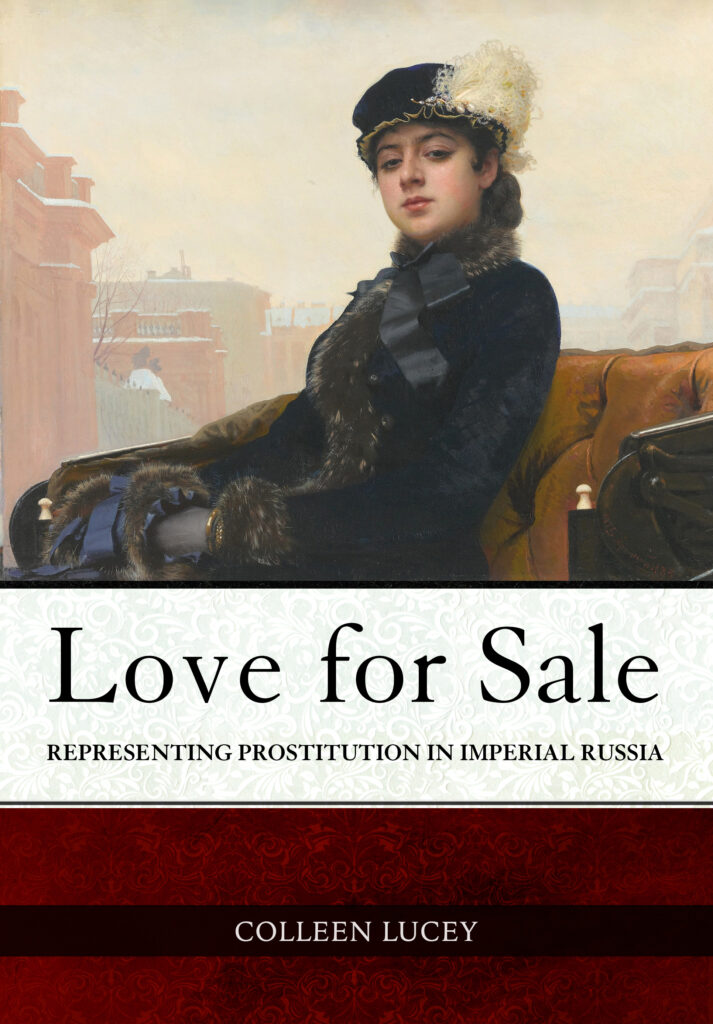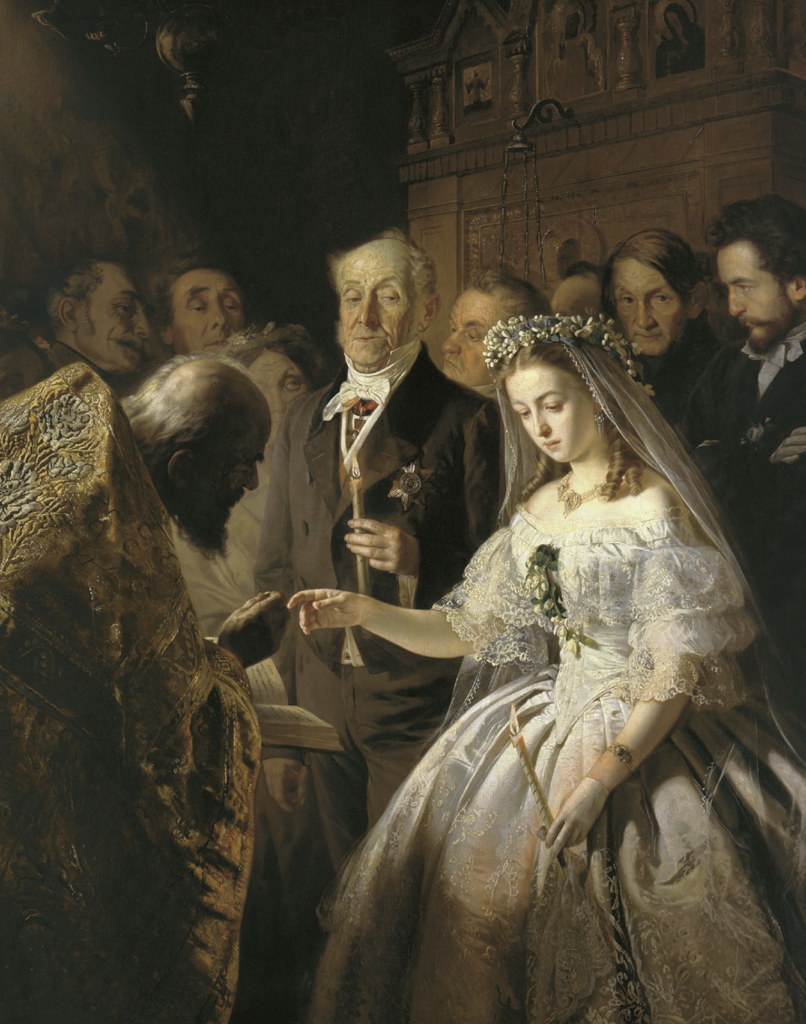Colleen Lucey
Colleen Lucey’s Love for Sale is the first work to examine the ubiquity of commercial sex in Russian literature and artistic production from the nineteenth century through the fin de siècle. The book offers a compelling account of how Russia’s elite used the topic of prostitution to comment on women’s shifting social roles at the end of tsarist rule and to express anxieties about the incursion of capitalist transactions in matters of love and fidelity.

NOTCHES: In a few sentences, what is your book about? Why will people want to read your book?
COLLEEN LUCEY: Love for Sale provides an overview of the contested forms of sexual commerce in imperial Russian culture. Using a wide range of sources—from canonical works of fiction by Tolstoy and Dostoevsky to little-known engravings that circulated in the popular press—the book charts how Russian writers and artists used the image of sex workers and other “fallen women” to discuss shifting perceptions of womanhood and femininity. That a woman might trade her sexual sanctity for a life of luxury caused great concern among Russia’s elite, and they devoted countless pages to codifying the prostitute’s tale as a tragic one. But even as writers produced harrowing tales of exploitation and abuse, a sexual subculture emerged that not only condoned, but even celebrated transactional relations and quid pro quo arrangements. Prostitution thus became a central focus for debating both the promises of modernity and the fears associated with women’s sexual, financial, and social autonomy. As the first work devoted to the theme of prostitution in imperial Russian culture, Love for Sale offers today’s readers a glimpse into Russia’s past, while also inviting them to consider how myths about the sex worker are recycled in the twenty-first century. Written to attract both specialists and non-specialists alike, the book provides crucial historical context for individual case studies and discusses issues as pertinent today as they were in the time of Dostoevsky.
NOTCHES: What drew you to this topic?
CL: I found it perplexing that so many Russian authors—most of them male—would turn to the sex worker’s tale for inspiration. Not only did they devote considerable time and energy into protesting Russia’s system of legalized prostitution (which was adopted in the 1840s and practiced until the Russian Revolution), many conducted ethnographic studies of brothel workers and wrote thoughtfully about sexual trauma. Although some stories read as patronizing to modern audiences, others provide complex psychological portraits of women who engage in commercial sex. While working on the book, I discovered that the range of depictions varied considerably; “fallen women” could be romanticized, lauded, and demonized, often in the same work of fiction. Likewise, the types of commercial sex represented in print and visual culture were much more diverse than I had originally assumed. I found that as the century progressed, Russian writers and their counterparts in the fine arts increasingly turned to the metaphor of prostitution to describe the conversion of women into capital at all levels of social exchange: parents bartering their daughters on the marriage market; bridegrooms “buying” younger women in marriage; demimondaines exchanging companionship for an apartment in downtown St. Petersburg; and madams enticing impoverished women to join their brothels. Uncovering this multifaceted cultural history felt urgent given the ongoing debate on sex workers’ rights in Russia. Recent controversies show how imperial discourse is recycled in contemporary Russia to justify the repression of nonnormative sexualities.
NOTCHES: This book engages with the histories of sex and sexuality, but what other themes does it speak to?
CL: The book weaves together the history of capitalism with the movement to emancipate women, and thus shows how Russians conceptualized both the promises and the dangers of monetizing sex. The chapters, while delving into particular types of sexual commerce, also chart the reception of capitalism as a major force driving the changes in social relations. For example, women are envisioned as consumers in early advertisements, but are themselves promoted as objects of consumption in popular lithographs. In this sense, the book also offers a history of early advertising, of capitalism and the construction of gender norms, and how the female body transfers between different modes of circulation.
NOTCHES: Were there any special exciting discoveries as you conducted research for your book?
CL: I spent several months in Russia in 2017 conducting archival research. While searching libraries, museums, and literary archives I discovered incredible primary sources that I didn’t know existed: drawings of brothel workers by major artists; albums depicting street walkers and brothel workers; graphic satire (caricature) in popular journals poking fun at extramarital love; and sketches of intimate encounters between sex workers and clients. Scholars of Russia have long assumed that no such images circulated in published works given strict censorship; however, my discoveries showed quite the contrary. Images of a sexualized leisure culture emerged in the mid-nineteenth century and considerably influenced perceptions of the female body.
NOTCHES: Did the book shift significantly from the time you first conceptualized it?
CL: I developed Love for Sale from my PhD dissertation, and while some core elements of the thesis remain in the book, much of the structure, argument, and evidence are different. For one, I significantly expanded my scope of study to include other forms of transactional relations beyond the brothel. The image of young, impoverished women “sold” in marriage to geriatric bridegrooms, as depicted in Vasily Pukirev’s famous painting Unequal Marriage (1862), started to catch my attention given the reoccurrence of this leitmotif in literature as well. This topic developed into a chapter on how the dowerless bride operates as a symbol of the monetization of marriage.

As I honed my theoretical approach, I began to study other “erotic dissidents” (to use Gayle Rubin’s term), the stratification of sexualities, and the contested role of women in the sex trade. I was drawn to the image of the madam, who is almost unanimously depicted as exploitative and conniving in literature and art. A chapter devoted to such “hyenas in bonnets” as commentators referred to them, provides commentary and analysis on how the madam and other female go-betweens are polarizing figures given their ability to work outside the patrilineal system to gain financial independence and social standing.
NOTCHES: Whose stories or what topics were left out of your book and why? What would you include had you been able to?
CL: I decided to focus on nineteenth-century Russian culture while writing Love for Sale, so unfortunately, I had to omit some later works that would have been exciting to include. There’s much more to say about how the image of sex work evolves in the wake of the Russian Revolution and the emergence of the Soviet Union. For instance, looking more at how Alexandra Kollontai conceptualized eros and rallied against prostitution would have been an interesting avenue to pursue. Likewise, my study focuses on images of female-identifying sex workers, but expanding to the twentieth century would allow for more engagement with same-sex commercial love.
NOTCHES: How do you see your book being most effectively used in the classroom? What would you assign it with?
CL: The first chapter, which examines images of “fallen women” in St. Petersburg would go well when teaching nineteenth-century Russian literature and culture surveys, especially during discussions related to Nikolai Gogol, Fyodor Dostoevsky, or Nikolai Chernyshevsky. History courses that take into account urbanization and the rise of cities could integrate chapter 2, which charts the sexualization of urban space through the prevalence of transactional sex in city centers. For classes devoted to the study of gender and sexuality, any of the book’s chapters could be adopted, but I’d point instructors to chapter 3, which looks at images of the demimondaine (elite sex worker) and how such women are depicted as consumers and objects of consumption. Chapters 4 (on dowerless brides) and 5 (on madams), expand sexual commerce to the realm of family life and marital transactions; as such, these chapters would fit nicely in graduate seminars devoted to the history of the novel or to the history of the women’s rights movement. Dostoevsky and Tolstoy remain at the center of many literature and culture courses; their comparable, yet often contradictory depictions of female subjecthood have stumped scholars and students alike. Assigning chapter 6, which looks at these two writers’ portrayals of kept women could prove helpful, especially because I integrate the overlooked female writer, Nadezhda Khvoshchinskaia into my analysis.
NOTCHES: Why does this history matter today?
CL: The topic of sex work remains highly contested, and the questions nineteenth-century thinkers were asking are not so different from the ones we pose today. The issue of sex workers’ rights has particular relevance in the post-Soviet context, as images of East European women sold into prostitution remain a hallmark of popular culture (through TV, film, and literature) and dominate conversations on sex trafficking in the political realm. But whether in popular culture or international policy, the impulse to humanize sex work often digresses into voyeuristic sensationalism. Instead of allowing sex workers to speak for themselves, artists and politicians speak on their behalf. The desire to appropriate the sex worker’s story for one’s own purposes is not new. Readers of Love for Sale will find the discursive tactics of nineteenth-century Russian artists oddly reminiscent of contemporary discussions on the regulation of women’s sexual and financial autonomy. In my analysis, I gesture to moments of convergence, when past and present theories on female sexuality collide. In this way, I allow readers to make their own connections between the patriarchal structures of imperial Russia and their contemporary iterations in today’s contexts.
NOTCHES: Your book is published. What next?
CL: I’m starting a new project on the conceptualization of women’s labor in Russian culture from the imperial period to the present. While conducting research for Love for Sale, I kept coming across references to work (trud), and the emancipatory aspects of labor for all people, but specifically women. I have long wanted to write about film and popular culture, so this project will allow me to do that while also fulfilling my lasting interest in gender and sexuality studies.
 Colleen Lucey is assistant professor of Russian and Slavic Studies at the University of Arizona. Her research and teaching interests include gender and sexuality in Russian literature and culture, the history of Russian theatre and performance (from the nineteenth century to the present), and Russian language instruction. Dr. Lucey’s scholarship has been supported by the Title VIII Research Scholar Program, the U.S.-Russia Peer-to-Peer Dialogue Program, and the Foreign Language & Area Studies Program. Her book, Love for Sale: Representing Prostitution in Imperial Russia, is out now with Cornell University Press.
Colleen Lucey is assistant professor of Russian and Slavic Studies at the University of Arizona. Her research and teaching interests include gender and sexuality in Russian literature and culture, the history of Russian theatre and performance (from the nineteenth century to the present), and Russian language instruction. Dr. Lucey’s scholarship has been supported by the Title VIII Research Scholar Program, the U.S.-Russia Peer-to-Peer Dialogue Program, and the Foreign Language & Area Studies Program. Her book, Love for Sale: Representing Prostitution in Imperial Russia, is out now with Cornell University Press.

NOTCHES: (re)marks on the history of sexuality is licensed under a Creative Commons Attribution-NonCommercial-NoDerivatives 4.0 International License.
Based on a work at www.notchesblog.com.
For permission to publish any NOTCHES post in whole or in part please contact the editors at NotchesBlog@gmail.com




